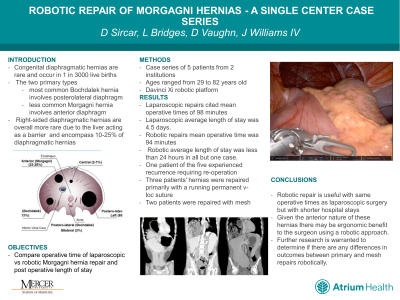Back

Hernia
Category: Quickshot Oral Session 10
Quickshot Oral : Quickshot Oral Session 10
ROBOTIC REPAIR OF MORGAGNI HERNIAS - A SINGLE CENTER CASE SERIES
Sunday, February 12, 2023
7:00am – 8:00am East Coast USA Time

- DS
Daniel Sircar, MD
General Surgery Resident, PGY 2
Atrium health Navicent - LB
Lindsey Bridges, DO
United States
Presenter(s)
Principal Contact(s)
Objectives: Congenital diaphragmatic hernias are rare occurring in 1 in 3000 live births. Two primary types described are the more common Bochdalek hernia involving the posterolateral diaphragm, and the less common Morgagni hernia (MH) involving the anterior diaphragm. Regardless of the type all diaphragmatic hernias are recommended to undergo repair. Minimally invasive surgery is an excellent option for repair. It is well described that laparoscopic approaches to these cases have less postoperative pain and earlier return to activity compared to open approaches, however sparse data remains comparing robotic to laparoscopic approaches.
Methods: We present a case series of 5 patients from 2 institutions who underwent robotic repair of a large MH. Our patients' ages ranged from 29 to 82 years old. All patients who underwent repair were symptomatic which prompted their workup. The mean length of surgery was 94 minutes (range: 52 to 190). Our mean length of stay post operatively was 28.8 hours (range: 24-48). Three patients' hernias were repaired primarily with a running permanent vloc suture while two patients were repaired with mesh. One patient of the five experienced recurrence requiring re-operation. The video shows one example of how we performed our primary suture repairs.
Results: The literature suggests a robotic versus laparoscopic approach to MH may be helpful due to the wrist articulation and “ceiling approach” where the focus of the field is at the top of the screen. Retrospective studies note laparoscopic diaphragmatic hernia repairs with mean operative times of 98 minutes, however the average length of stay for these patients was 4.5 days. Our mean length of surgery was comparable at 94 minutes however the length of stay for the patient was less than 24 hours in all but one case. Wei et al described a case series of 4 robotic MH repairs (all right sided) that they performed an abdominal approach to repair noting the average operative times at 129 minutes and average length of stay at 2 days. The one patient who experienced recurrence in our series had a primary vloc suture repair.
Conclusion: While MH represent a small subset of diaphragmatic hernias, consideration should be given to robotic repair as it may lend to shorter hospital stays. Additionally, given the anterior nature of these hernias there may be ergonomic benefit to the surgeon using a robotic approach. Further research is warranted to determine if there are any differences in outcomes between primary and mesh repairs robotically.
Methods: We present a case series of 5 patients from 2 institutions who underwent robotic repair of a large MH. Our patients' ages ranged from 29 to 82 years old. All patients who underwent repair were symptomatic which prompted their workup. The mean length of surgery was 94 minutes (range: 52 to 190). Our mean length of stay post operatively was 28.8 hours (range: 24-48). Three patients' hernias were repaired primarily with a running permanent vloc suture while two patients were repaired with mesh. One patient of the five experienced recurrence requiring re-operation. The video shows one example of how we performed our primary suture repairs.
Results: The literature suggests a robotic versus laparoscopic approach to MH may be helpful due to the wrist articulation and “ceiling approach” where the focus of the field is at the top of the screen. Retrospective studies note laparoscopic diaphragmatic hernia repairs with mean operative times of 98 minutes, however the average length of stay for these patients was 4.5 days. Our mean length of surgery was comparable at 94 minutes however the length of stay for the patient was less than 24 hours in all but one case. Wei et al described a case series of 4 robotic MH repairs (all right sided) that they performed an abdominal approach to repair noting the average operative times at 129 minutes and average length of stay at 2 days. The one patient who experienced recurrence in our series had a primary vloc suture repair.
Conclusion: While MH represent a small subset of diaphragmatic hernias, consideration should be given to robotic repair as it may lend to shorter hospital stays. Additionally, given the anterior nature of these hernias there may be ergonomic benefit to the surgeon using a robotic approach. Further research is warranted to determine if there are any differences in outcomes between primary and mesh repairs robotically.

